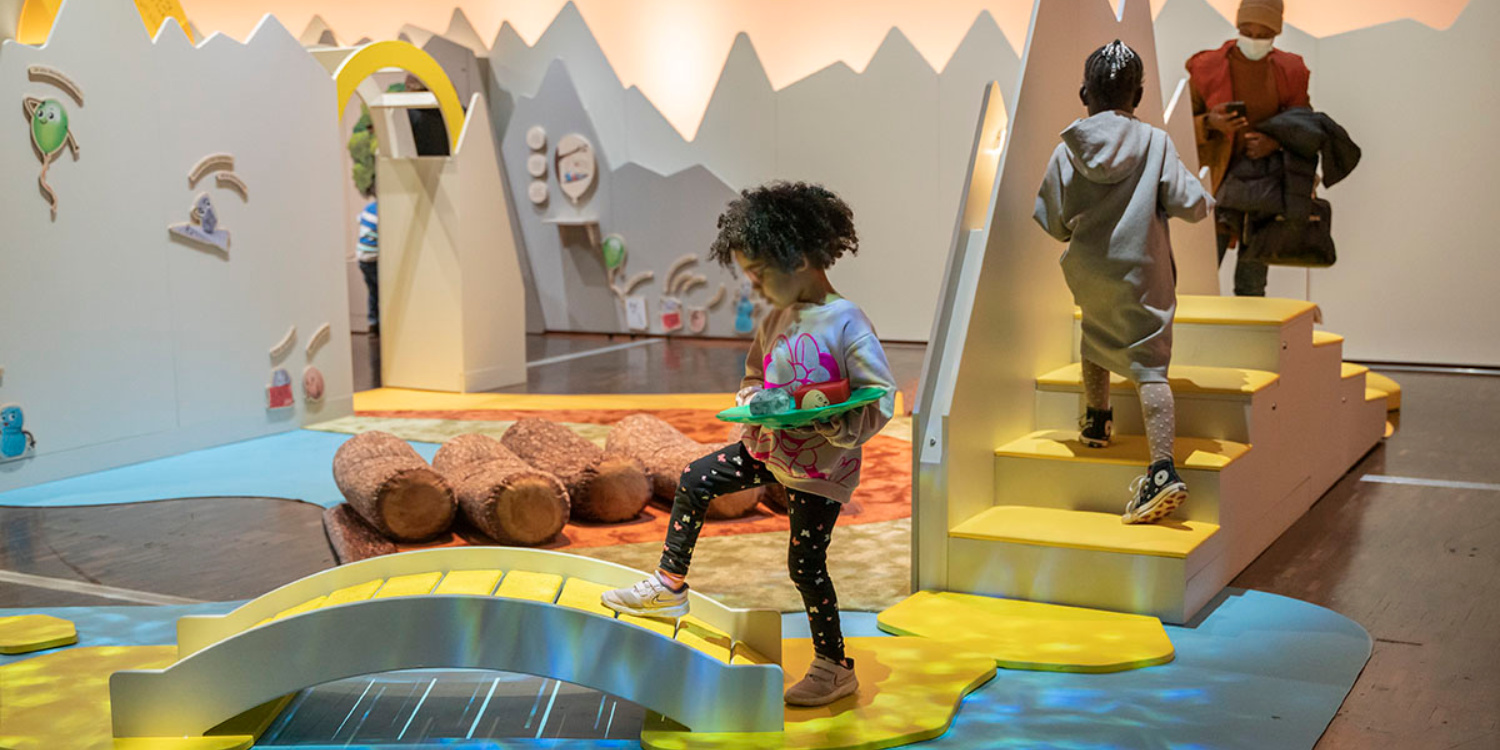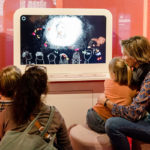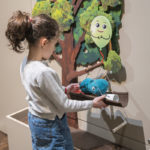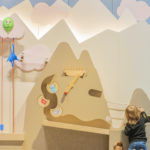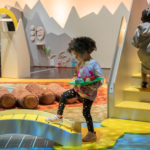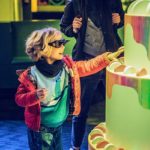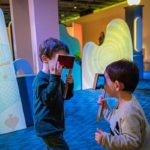Hélène Wang, head of touring experiences development and production, and Stéphane Savard, head of logistics for touring exhibitions at Universcience – Cité des sciences et de l’industrie & Palais de la découverte, share an insight into the development and logistics of touring exhibitions created specifically for younger audiences – unveiling multidisciplinary creative insights, and production and logistics challenges involved in the development of their “Young and Curious” exhibitions.
Teo: “Making science big for kids” is at the heart of what your team does at Universcience, creating experiences for your science venues, the Cité des sciences et de l’industrie, and the Palais de la découverte in Paris, but also for partner institutions in France and internationally, notably with touring exhibitions. Over the past 2 years, your team has been focusing particularly on the development of a range of “Exhibitions for the Young & Curious”, designed for touring. Could you tell us about these “Young and Curious” experiences, and how they differ from other travelling exhibitions?
Hélène Wang and Stéphane Savard: The “Young and Curious” experiences are a key initiative led by the Universcience team over the past 6 years, since 2018, to explore new paths of science engagement for the younger audiences. They are conceived to provide our youngest visitors with participatory experiences, which take advantage of the latest advances in educational science, and encourage them to discover the world around them. This was a natural development for us, since Universcience has been developing and sharing a unique expertise in cultural engineering and edutainment museology for young audiences for now 30 years. The new “Young and Curious” exhibitions comes thus as a new part of our wider offer of expertise in the creation of attractive cultural destinations for children.
With the “Young and Curious” portfolio, our core focus is on kids aged 2 to 11, with a great attention to their families. The approach differs from more classic travelling exhibitions in the sense that these exhibitions provide low tech, hands on, contemplative and active experiences, designed specifically to engage with non-readers and early readers, but also their families, with an international and inclusive approach.
These exhibitions provide low tech, hands on, contemplative and active experiences, designed specifically to engage with non-readers and early readers, but also their families.
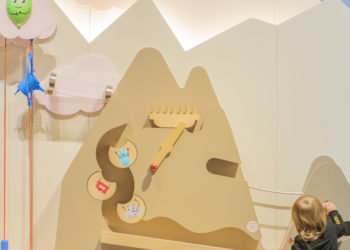
How does your team select the topics to address in these new exhibitions? What are the first topics you have been working on?
Our curators, and our marketing and project management teams, work together to identify themes that will bring our young visitors’ attention to science through concrete angles, and encourage them to be curious about their world. We search for easy entry points, themes that can speak to the largest numbers and which naturally spark curiosity. In that process, we seek for themes that are off the beaten track, and which can favour art & science angles.
We started the “Young and Curious” adventure with Opposites, which invited visitors to explore contrasting perceptions and nuances, and Playhuts, which took our young visitors inside unusual and poetic playhuts. Following the success of these first “Young and Curious” productions, we created, in 2022, Fragile!, which takes children on multiple explorations that leads them to experience the concept of fragility. We also produced, in 2023, Metamorphoses, where they can explore the scientific dimension as much as the almost magical aspect of transformations.
This year we will open our brand-new production, Dance. As one of the earliest forms of self-expression for children, dance is a very natural theme, very well suited for a “Young and Curious” experience. The exhibit will explore dance both as an activity to enjoy, and a subject of study. For this show, we will turn galleries into a ballroom and a dance studio, it will be very unique.
How do you build your inclusive and international approach for these productions?
With openness and innovation, inclusiveness is a core value of our institution, and from the very first steps, we integrate this requirement in the development of our exhibitions. Our specific focus on young audiences comes from this, our will to make sure that we truly engage with the widest audiences and take into account their specific needs, in all the activities we develop.
For each show, we work specifically to make sure the experience is accessible and enjoyable for the widest audiences. And that involves continuous study of audiences. This even led us, for Metamorphoses, to involve young children very early in the process. We worked with a large class group of children aged 6 to 11 years old to develop the exhibit. We discussed the ideas of transformations with them, and this interaction sparked great ideas and helped us design experiences that truly engage with this specific audience.
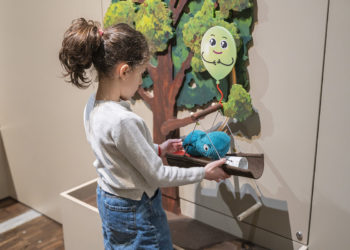
We specifically select topics and types of experiences that can engage audiences from different regions around the globe, that have some kind of universal appeal.
With each exhibition, we also provide a mediation toolkit, which supports scientific facilitators in their work engaging with the younger audiences and their families.
The international appeal of the created experience is also key for us, as part of this approach we have, to share science with the widest audiences, beyond our walls. We specifically select topics and types of experiences that can engage audiences from different regions around the globe, that have some kind of universal appeal. Topics which can arouse curiosity with the largest audience.
To that purpose we also of course foster flexible design which enables to easily adapt to a variety of exhibition rooms, with preconceived versions enabling the presentation in small venues all the way to big venues, and makes it possible to quickly install, dismantle, pack and unpack, transport and store, the complete exhibition set ups and displays. We have a full process for flexible size adaptations, language adaptations, and our exhibitions are designed with robust and easy-to-maintain materials to enable multiple venue touring. National and international touring is part of the process from concept stage for each project.
How do you create the environments for these discoveries? How is the overall exhibition design specifically conceived for younger audiences?
For each exhibition, our creative team brings together a multidisciplinary team of curators, scientists, designers and logistics experts, who come up with a unique experience that takes into account all the different requirements we have originally established: innovative science engagement, inclusiveness, tourability and logistics constraints, modularity, life cycle and reuse management etc. This team work also guides our design team in creating an environment that integrates these prerequisites and provides a truly immersive and multisensory experience for our young visitors.
For the “Young and Curious” exhibitions, we aim at creating warm, colourful and poetic environments, where we make sure that small visitors can feel comfortable, safe and excited to discover. Often, the exhibition’s itinerary is self-guided and intuitive, so that children are free to discover and move from one world to another according to their own inclinations.
As an example, in Metarmorphoses, we have created five universes, with their own visual identity and engagement approach, called A Thousand and One Eyes, Mirror, Mirror on the Wall, The Funfair, The World of Shadows and the Amazing Forest. Visitor travel from one to the other, to discover different principles that lie at the heart of metamorphosis.
We also use storytelling specifically in these exhibitions, as it is powerful tool to engage with young visitors, but also older ones. For example, the curator of Fragile! created totally new characters. She invited children and their parents to travel the tiny world of Windy, Iggy, Folia, Glitch, Woolma and Roky – who were a balloon, an egg, a sheet of paper, a bar of soap, a ball of wool and a stone.
Low tech interactivity is indeed an important specificity of our travelling exhibitions [...]. We work a lot with hands on manual interactivity, which is key for young visitor engagement.
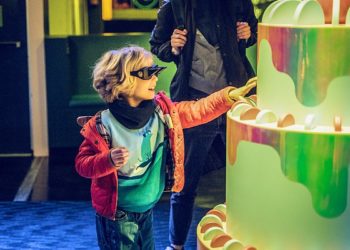
You mentioned parts of these experiences are specifically designed to be low tech. How do you create low tech interactivity for younger audiences, for these travelling exhibitions?
Low tech interactivity is indeed an important specificity of our travelling exhibitions, which lies at the heart of our creative process. We work a lot with hands on manual interactivity, which is key for young visitor engagement, and also create a pace with contemplative moments, moments of exploration and feel, and moments which encourage discussion between children and adults who accompany them. In Fragile! for example, we created many hands on manual interactives, where the little visitors could make the characters move, create new objects, and repair elements. In Playhuts, kids could lie down inside the huts, discover the wall textures, colours, shadows. In Metamorphoses, we are having great success with our shadow theatre, where kids can dress up and create shadow forms.
This does not mean we do not have screens in the exhibition. But there are fewer high-tech moments in the visitor journey, integrated only when they serves educational and engagement purposes. And these are specifically conceived for younger audiences. For example, in Metamorphoses, we integrated an animated film about our journey through life, which follows a boy from birth to old age, to illustrate how we are constantly undergoing transformations as human beings. Using the format of simple animation, which adults and children can watch together, is a powerful tool to engage visitors, and enables to give them a space where they can sit for a little while.
In terms of logistics, do these exhibitions present particular challenges?
For these projects as for all our travelling exhibitions, our marketing and development team works closely with our logistics team, from the start of the project, to ensures the best integration of logistical constraints into the exhibition design and tour planning. The marketing team assesses and shares venue expectations. The logistics team supports the design team when the different versions of the show, which will be proposed to potential venues, are created. Universcience works with three versions of exhibitions: large format, adapted format and small formats. Volumes and design are carefully optimised to reduce transport, installation and storage costs. We work together on content and modularity, to make sure that the smaller version is designed to provide the best experience with the shortest installation and most optimised costs. This is essential to make the show accessible to the smaller venues.
Exhibitions mentioned
Metamorphoses, by Universcience
Opposites, by Universcience
Fragile!, by Universcience
Playhuts, by Universcience
Dance, by Universcience

